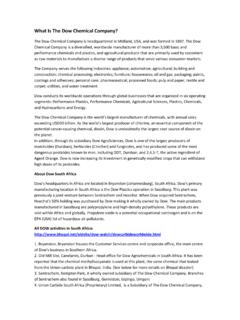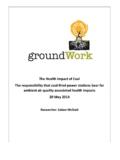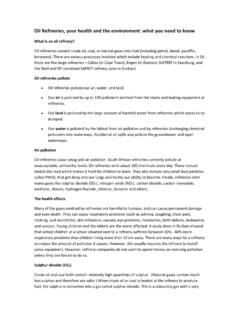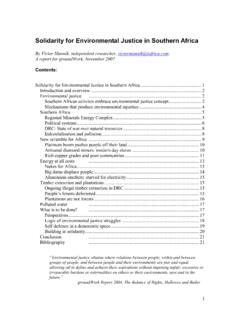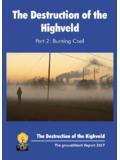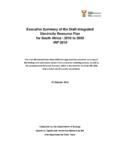Transcription of Integrated Energy Plan (IEP) and Integrated …
1 Integrated Energy plan (IEP) and Integrated resource plan (IRP) 2016 . Comments by groundWork, Friends of the Earth, South Africa and Earthlife Africa Jhb Date: 31 March 2017 E-mail: Introduction The IEP is the overall Energy plan for liquid fuels (petrol, diesel, paraffin), gas and electricity. The IRP is the more detailed plan for electricity. Both plans make projections of Energy / electricity demand through to 2050 and consider how to supply that demand. The IEP contains four different scenarios which result in different levels of demand. The IRP does not refer to these scenarios but uses electricity demand projections developed by the CSIR. The final policy adjusted version of the IRP, as approved and promulgated by cabinet, will provide the legal basis for ministerial determinations on what capacity should be added to the electricity system in the following years. The new plans have been much delayed.
2 At present, the IRP 2010 (actually approved in March 2011) provides the legal basis for decision making. The first paragraph says: The Integrated resource plan (IRP) is a living plan that is expected to be continuously revised and updated as necessitated by changing circumstances. At the very least, it is expected that the IRP should be revised by the Department of Energy (DoE) revision in 2012. In 2013, the DoE produced a draft of the first IEP and an IRP 2010 update and invited public comment. The changing circumstance noted in the update was a substantial reduction in forecast Energy demand. (groundWork observed that the 2010 forecast was grossly exaggerated and the 2013 forecast was still way too high.) In consequence, new nuclear power should be delayed for a decade if not forever. Following public workshops, however, the 2013 process disappeared. The DoE made no announcement that the process was delayed or suspended or terminated.
3 It said nothing at all. Over the next two of years, the circumstances kept on changing. Not only did demand grow less rapidly than forecast, it shrank. And the cost of renewables declined faster than was 2 expected. Meanwhile, it leaked out that President Jacob Zuma had led clandestine negotiations with Russia s President Putin for Russia to supply a fleet of nuclear power stations. This confirmed suspicions that the 2013 process was stalled because it was likely to result in nuclear power being deleted from South Africa s Energy plans. In 2014 and 2015, perhaps as a way of managing civil society demands, it was variously rumoured that the process would be revived. In early 2016 , it was said that the plans would be presented to cabinet for approval ahead of public consultations. In October, a version of the IEP was presented to the parliamentary committee and, on 17 November, cabinet announced that it had discussed, amended and approved a version for public consultation.
4 Over three years after stalling the 2013 process, the Department of Energy (DoE) presented the IEP and IRP base case at a press conference on 22 November 2016 . They posted the actual documents on the website on 25 November. They then also posted a schedule of consultations in Johannesburg, Durban, Cape Town and Port Elizabeth beginning Wednesday 7 December two weeks after their presentation and just eight working days after the documents were posted. The DoE asked for comment on the assumptions behind both plans and on the IRP base case. Some background papers on the assumptions were posted only on 7 December. Others are yet to be posted and a DoE paper on nuclear costs is apparently secret. This looked like a dishonest process designed to limit rather than facilitate participation. The substance of the plans was equally problematic. In particular, the IRP inflated the known costs of renewables while depressing the costs of coal and nuclear.
5 It also put an arbitrary limit on how much renewable Energy could be added each year. Most observers concluded that the DoE had distorted the data to favour coal and nuclear and were steamrolling the process to limit debate. During the consultation workshops, the DoE repeatedly said that this was not their intention. They said they would consider extending the time periods for consultation. In particular, they said they would ensure that communities affected by the Energy system that is the fenceline communities next to coal mines, power stations, coal-to-liquid plants and oil refineries would be able to comment on the plans. On 23 December, the DoE posted a new schedule for consultations in Kimberly, Polokwane, Nelspruit, Mafikeng and Bloemfontein starting 23 January. groundWork emailed the DoE to note that this did not enable comment by communities on the Highveld, the Vaal and the Waterberg but did not receive a At the same time, the DoE extended the deadline for written comments from 15 February to 31 March 2017.
6 1 E-mail from gW to DoE: RE: IEP and IRP public consultation notices, 29 December 2016 . 3 The IEP Objectives, scenarios and assumptions The policies that shape the IEP starts with Energy policy, and includes: overarching national policies the National Development plan (NDP) and the New Growth Path; industrial action plans and policy for beneficiation; the National Transport Master plan ; and the Climate Change Response Policy and the carbon tax proposal. From this, the IEP identifies eight objectives supposed to be of equal weight. Some, however, seem more equal than others. First up is security of Energy supply (demand must be met) followed by: minimise cost; increase access; diversify Energy sources; minimise CO2 emissions (other pollutants are not included); improved Energy efficiency; economic localisation, technology transfer and job creation; and water conservation.
7 The IEP creates four scenarios to describe potential Energy futures for South Africa: - The Base Case is business-as-usual and assumes existing policies are implemented ; - resource Constrained comes with high fossil fuel prices due to limited supply ; - Environmental Awareness comes with tighter emission limits and higher costs for externalities; - Green Shoots sees the successful implementation of the NDP with high economic growth and a shift from primary minerals to manufacturing and services. Macro-economic assumptions include a discount rate of , down from a very high used in 2013. A high rate has two major implications: first, investing now to avoid the future impacts of climate change just doesn t make economic sense; second, investments with high upfront costs but low future costs (such as renewables) are discouraged. The second economic assumption concerns the rate of GDP growth which is critical to calculations of future demand.
8 The top part of table 1 is taken from the IEP Annexure B: Macroeconomic Assumptions [3]. It says the figures are based on National Treasury s most recent in-house estimates of growth . Since the paper is not dated, it is not clear when most recent was. The bottom line in the table is taken from a Treasury presentation made in November 2016 . Table 1: Forecast GDP growth and actual growth (%). Short term Medium term Long term 2014 2015 2016 2017 2018-2022 2023-2050 Low growth Moderate growth High growth Actual growth 4 Source: IEP Annexure B: Macroeconomic assumptions (not dated). Actual from Treasury Investor Presentation, November 2016 . The IEP uses the moderate growth forecast in all scenarios except Green Shoots which is based on the NDP s wished for growth of till 2030. Actual growth, however, has fallen well below the low growth forecast. As usual, Treasury sees recovery around the corner but its November forecasts for the next three years still come in below low growth : in 2017, in 2018 and in 2019.
9 In the longer term, the low growth projection still looks optimistic. There are three major reasons for this. First, the so called great recession is not over. Outright depression has been kept at bay only by the big central banks blowing bubbles and inflating stock prices. This will not be sustained but the costs are meanwhile pushed onto those who the global economy makes vulnerable. Second, the economic impacts of climate change and environmental damage will increase exponentially. Third, the social costs of maintaining capital on the one hand and of climate change on the other will increasingly destabilise society. The third economic assumption concerns fuel prices. The IEP assumes future oil and gas prices based on International Energy Agency (IEA) forecasts, shale gas prices based on PetroSA data and coal prices based on data from the Electric Power Research Institute (EPRI), a consultancy from California.
10 The IEA represents establishment views and its forecasts generally give a rose tinted view of future Energy market growth. It is not clear what credibility should attach either to PetroSA or EPRI. The IEP fixes coal and shale gas prices for the entire period to 2050. This may reflect the difficulty of price forecasts but creates a false stability. We think it rather more likely that international markets will be defined by price volatility with shortening boom-bust cycles. Despite Eskom s dominance, the churn will enter the local coal market for three inter-related reasons: first, the break-up of the MEC is both symptom and cause of instability; second, Eskom is favouring short term contracts and spot buying at the expense of long term agreements; and third, the central coal fields of the Highveld are in decline. Demand Security of Energy supply is the first named of the IEP s objectives. A fundamental objective of the IEP is to ensure that all projected future Energy demand is met [42].
